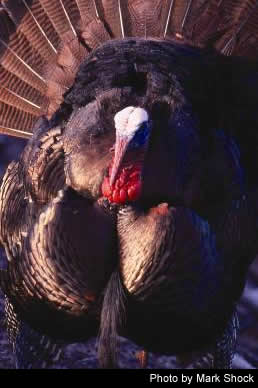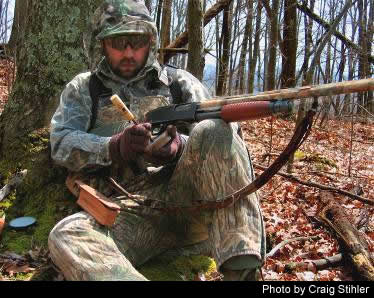

Getting The Goods on Gobblers By Jim Pack In no other state can a wild turkey hunter secure more information about spring gobbler hunting and seasons than in West Virginia! While that may seem like a bold, if not arrogant statement, it's true. West Virginia's “Spring Gobbler Survey,” an informative survey started in 1983, is the longest running gobbler hunting survey in the United States. DNR biologists established two goals at the onset. One was to provide wildlife biologists with additional information to guide management of the state's valuable wild turkey resource. The second goal, and just as important, was to provide a forum for hunters to present their opinions, experiences and knowledge for the state's management of wild turkeys and wild turkey hunting. Because the survey has such a long history, it would be impossible to cover every facet in one article. Fifteen different categories of information and over 125 different subjects have been covered since 1983. Some more notable categories are wild turkey biology, turkey calls, firearms, hunting and daily hunting records that cover everything from gobbling, hunting success, foods, and weather conditions to species and numbers of wildlife seen. In a recent survey conducted in 2004, cooperators learned that gobbling was not as good as in 2003. In addition, the normal peak in gobbling did not occur the first week of the season, but instead, more hunters heard more gobblers on May 4, during the second week of the hunting season. Another major peak in gobbling occurred as late as May 11. This phenomenon has occurred in other years. Consequently, hunters need to remember that spring gobbler hunting can be quite different from hunting other game species. Good gobbling and good hunting can occur later into the season. Cooperators also learned that the best gobbling in 2004 was in our southwestern counties. This was in contrast to the previous year when our western and northern panhandle counties won the honors of having the best gobbling. It took hunters an average of 43 hours of hunting to bag a gobbler in 2004. This means that anyone contemplating spring gobbler hunting should realize that it is one of the most challenging hunting sports. It is not the type of hunting recreation where one should expect instant harvest gratification. However, it is most rewarding because the average hunter does hear one or more gobblers per day, and hearing a bird gobbling or watching spring unfold makes the day for a gobbler hunter. A typical spring gobbler bagged in 2004 was older and bigger than normal. The average age of a gobbler taken was 2.8 years, and the typical bird weighed 18.5 lbs, had a 9.4-inch beard, and one-inch spurs. Birds were older because two bad brood years in a row led to fewer jakes (one-year old birds), and two-year old adults. Over the years, some questions have been asked repeatedly to learn about trends. For example, 15 years ago, only 27 percent of our cooperators used three-inch shotgun shells while today 63 percent use them. Back in 1983, 88 percent of our hunters used a diaphragm call. More recent surveys show the diaphragm call is the favorite of less than 50 percent of our hunters. This question will be asked again in 2005 to keep our findings current. All hunters would be wise to remember the answer to one very useful question asked a few years ago: “What mistakes did you make while hunting?” The most common blunder was trying to get too close to a turkey before calling, second was not having enough patience, third was a poor set up, and tied for fourth was calling too much and shooting too far. The survey has even answered the question how far is shooting too far. Repeatedly, results show the average distance that hunters cripple gobblers is 38 yards. Couple this information with the average distance hunters have killed birds (28-32 yards), and one can see it is risky to achieve a sure kill at distances much over 30 yards. These are facts that hold up even though some of our survey participants use 10 gauges, 3 1/2 inch shells, tight chokes, scopes and every other imaginable device to improve success. New questions are added periodically to the survey. Last year, hunters recorded crop contents of gobblers bagged, and we learned that green vegetation (46 percent) and insects (21 percent) made up two-thirds of the content. Actually, 15 percent of the crops of harvested birds contained no food items. Two years ago hunters started recording the intensity of gobbling along with the number of birds heard. More recently, sightings of most of our major game species have been added to the survey. This data on white-tailed deer will give biologists population trend data after the hunting season, which is valuable information to wisely manage this wildlife resource. A few years ago “coyotes seen by hunters” was added to the survey. This information, along with the Bowhunter Survey reports, are the major tools used to monitor the distribution and population trend of this predator in West Virginia.
One of the most enjoyable parts of the survey is the remarks and comments conveyed to the Gobbler Survey Committee who puts the results together each year. Some of the stories and comments are so unbelievable that they have to be true. One recent favorite presented here in the writers own words is as follows: “5/14…I had four 3 or 4 year-old gobblers fighting 2 gun lengths away, with 2 birds with 1-½ inch or better spurs strutting around them. One of them tripped over my boot. At one time 3 of them had the other one by the neck and they had him lifted off the ground about a foot. They were all twisting his neck and slamming his head against a tree. I thought they were actually going to tear his head off. This went on for at least 10 minutes. I saw a coyote come slipping in and about 5 seconds later a squirrel jumped around the tree I was sitting beside and landed on the side of my face. Needless to say everything came unglued at this time.” Hunters are asked to write about the highlight of their season. These highlights are often thought provoking, touching, and real blessings to read, and perhaps, repeating a couple of them is the best way to end this article. One hunter wrote in our last survey, “Calling in gobbler for 15-year old, but no shot available; he said ‘we were so close when he gobbled I felt the whole earth shake!'” One thoughtful cooperator said, “Dedicated my season to our troops.” Jim Pack recently retired as a wildlife biologist in Elkins. |

